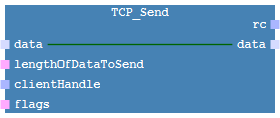TCP_Send block
Short summary
|
Name |
TCP_Send |
|
→POU type |
|
|
Category |
more system blocks, network blocks, block with internal error diagnostic |
|
logicals.system.network.tcp |
|
|
Graphical interface |
|
|
Available since |
version 3.2.2 (for library
Standard
)
|
Functionality
The block sends a →TCP packet.
Inputs, outputs, return value
|
|
Identifier |
Description |
|
|
Inputs: |
lengthOfDataToSend |
UDINT |
length of the data to send |
|
|
clientHandle |
TCP_ClientHandle |
TCP h andle |
|
|
flags |
UDINT |
additional flags for sending |
|
In-outs
|
data |
REAL, LREAL, USINT, UINT, UDINT, ULINT, SINT, INT, DINT, LINT, TIME, BOOL, BYTE, WORD, DWORD, LWORD, STRING, CHAR, DATE_AND_TIME, DATE, TIME_OF_DAY or a →user-defined data type |
content of the sent TCP packet |
|
Return value: |
– (= rc ) |
TCP_ErrorCode |
returns the status of the TCP operation:
|
Input EN and output ENO are available when →calling the block. See "Execution control: EN, ENO" for information on input EN and output ENO.
See:
"Blocks for safe logic" whether this block is supported for developing safety-relevant applications.
"Highlighting safe logic in the FBD-editor" for the effects when using the block as a block for safe logic .
Internal error diagnostic for block
The block checks the following error cases:
The flags are invalid .
T he handle is invalid .
The data cannot be sent.
The length of the data is invalid.
In such an error case, the output ENO of the block is set to value FALSE (or an equivalent). Moreover, the block returns the appropriate code (see the above table).
Example for usage within ST-editor
See " TCP_ServerOpen block ".
When creating your application within the ST-editor, enter a call of a block by typing the text as requested by the syntax or use Content Assist.
